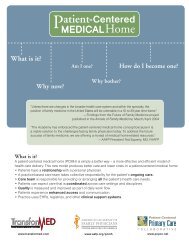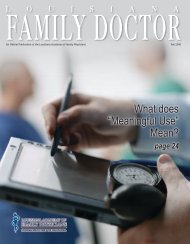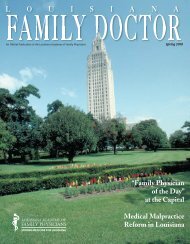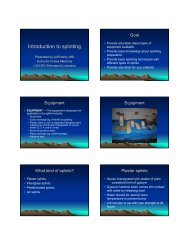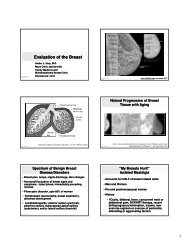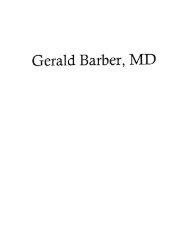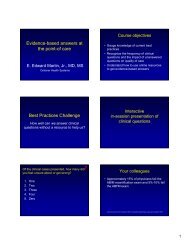New Drug Update 2009-2010 - LAFP
New Drug Update 2009-2010 - LAFP
New Drug Update 2009-2010 - LAFP
You also want an ePaper? Increase the reach of your titles
YUMPU automatically turns print PDFs into web optimized ePapers that Google loves.
Liraglutide – Victoza by Novo-Nordisk<br />
INDICATIONS: Liraglutide is a glucagon-like peptide-1 (GLP-1) receptor agonist indicated as an adjunct<br />
to diet and exercise to improve glycemic control in adults with type 2 diabetes mellitus.<br />
Important Limitations of Use:<br />
•Not recommended as first-line therapy for patients inadequately controlled on diet and exercise.<br />
•Has not been studied sufficiently in patients with a history of pancreatitis. Use caution.<br />
•Not for treatment of type 1 diabetes mellitus or diabetic ketoacidosis.<br />
•Has not been studied in combination with insulin.<br />
CLINICAL PHARMACOLOGY: Liraglutide is a human analog of the glucagon-like peptide-1 (GLP-1) with<br />
97% amino acid sequence homology to endogenous human GLP-1. It differs from human GLP-1 by the<br />
addition of a C14 fatty acid. As a GLP-1 analog, it induces its activity through a glucose-dependent<br />
stimulation of insulin secretion, inhibition of glucagon secretion, slowing of gastric emptying, and<br />
reduction in appetite. Liraglutide also improves beta cell function in patients with type 2 diabetes.<br />
GLP-1 has a half-life of 1.5-2 minutes due to degradation by the ubiquitous endogenous enzymes,<br />
dipeptidyl peptidase IV (DPP-IV) and neutral endopeptidases (NEP). Unlike native GLP-1, liraglutide is<br />
stable against metabolic degradation by both peptidases and has a plasma half-life of 13 hours after<br />
subcutaneous administration. The pharmacokinetic profile of liraglutide, which makes it suitable for once<br />
daily administration, is a result of self-association that delays absorption, plasma protein binding and<br />
stability against metabolic degradation by DPP-IV and NEP.<br />
Fasting and postprandial glucose was measured before and up to 5 hours after a standardized meal after<br />
treatment to steady state with 0.6, 1.2 and 1.8 mg liraglutide or placebo. Compared to placebo, the<br />
postprandial plasma glucose AUC0-300min was 35% lower after liraglutide 1.2 mg and 38% lower after<br />
liraglutide 1.8 mg.<br />
PHARMACOKINETICS: Liraglutide is slowly absorbed following subcutaneous administration, reaching<br />
peak levels at 9 to 12 hours after dosing. Absolute bioavailability is 51%. Pharmacokinetics were similar<br />
with administration in the upper arm, abdomen, and thigh. A dose-proportional increase in exposure was<br />
observed with increasing doses over a dose range of 1.25 to 12.5 mcg/kg.<br />
Liraglutide 20 mcg/kg administered once daily subcutaneously exhibited less peak to trough variation<br />
than exenatide 10 mcg/kg administered twice daily subcutaneously.<br />
Liraglutide has a half-life of 11 to 15 hours following subcutaneous administration; allowing for once daily<br />
subcutaneous administration. Liraglutide is metabolized to a number of minor metabolites, which are<br />
excreted in the urine and feces. Liraglutide excretion in the urine is negligible.<br />
Liraglutide pharmacokinetics were not substantially altered in subjects with renal function impairment,<br />
including subjects with severe renal function impairment (creatinine clearance less than 30 mL/min) or<br />
end-stage renal disease requiring dialysis. Liraglutide is not significantly removed by dialysis. Liraglutide<br />
exposure appears to be reduced in patients with hepatic function impairment. Patients with renal or<br />
hepatic function impairment should be dosed according to their glycemic control.<br />
Elderly -Age had no effect on the pharmacokinetics of liraglutide based on a pharmacokinetic study in<br />
healthy elderly subjects (65 to 83 years) and population pharmacokinetic analyses of patients 18 to 80<br />
years of age.<br />
Gender -Based on the results of population pharmacokinetic analyses, females have 34% lower weightadjusted<br />
clearance of liraglutide compared to males. Based on the exposure response data, no dose<br />
adjustment is necessary based on gender.<br />
Race and Ethnicity -Race and ethnicity had no effect on the pharmacokinetics of liraglutide based on the<br />
results of population pharmacokinetic analyses that included Caucasian, Black, Asian and Hispanic/Non-<br />
Hispanic subjects.<br />
31




